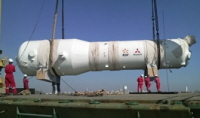More MHI steam generators for EdF
12 May 2010
Mitsubishi Heavy Industries (MHI) is to manufacture three replacement steam generators for one of Electricité de France's (EdF's) reactors. The order brings the total number of the components supplied by MHI to France to 15.
 |
| One of the MHI steam generators already supplied to EdF (Image: MHI) |
The contract for the steam generators, destined for an unnamed French 900 MWe pressurised water reactor (PWR), was awarded jointly to a collaboration of Japan's MHI and French company Comex Nucléaire through an international bidding procedure. The 21 metre high, 300 tonne components will be manufactured at MHI's Kobe Shipyard and Machinery Works, with delivery scheduled to begin in 2016.
Steam generators play a crucial role in PWRs, transferring the thermal energy generated in the reactor vessel to a secondary coolant loop and feeding the resulting steam to a turbine system to generate electricity, as well as providing a pressure boundary for the primary coolant circuit. They comprise a pressure-resistant container made of low-alloy steel (containing manganese, molybdenum and nickel), housing more than 4000 heat transfer tubes made from a thermally treated nickel-chromium-iron alloy.
The manufacture of such large, specialised components requires sophisticated and ultra-precise technology, and the number of companies around the world that can supply them is limited – although Areva's Chalon/Saint Marcel facility in eastern France is one of them. MHI boasts orders for 31 replacement steam generators from around the world in recent years, including the total of 15 ordered by EdF since 2005.
EdF operates a fleet of 58 PWRs, 34 of which are 900 MWe types which came into operation in the late 1970s and 1980s. The company is sequentially replacing the steam generators at its PWRs, a major undertaking but one that can enable the units' operating lives to be extended. In July 2009 the French Nuclear Safety Authority (ASN) approved EdF's safety case for 40-year operation of the 900 MWe units, based on generic assessments.
Researched and written
by World Nuclear News